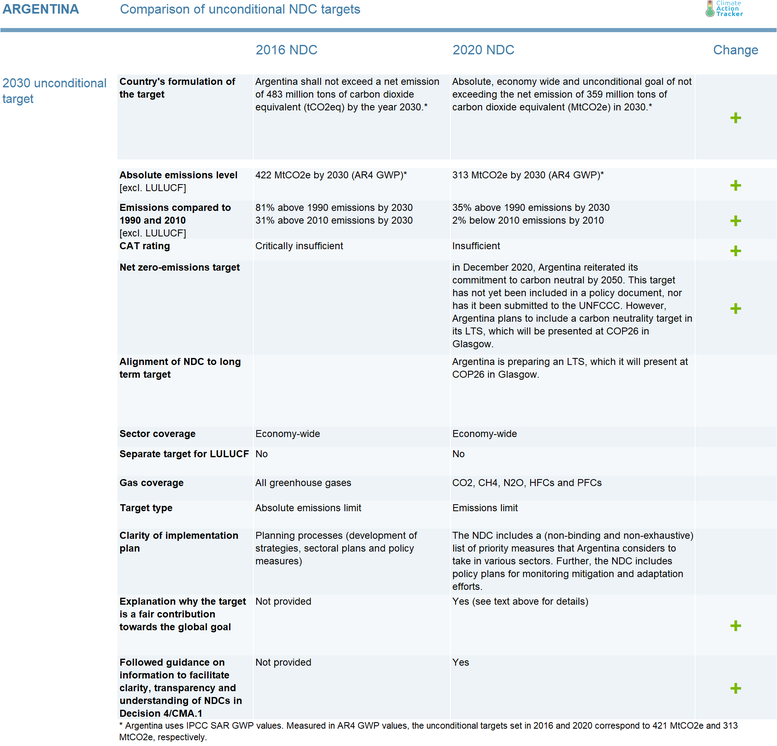CAT Climate Target Update Tracker
Argentina
Summary
Update: On 22 April 2021, Argentina's President announced at the Leaders’ Summit on Climate that they will increase their climate action, beyond what was submitted in the second NDC last December. We estimate the announced improvements translates into a further 2.7% reduction of emissions (excluding LULUCF) compared to their last NDC submission. We will analyse this new commitment once Argentina makes an official submission to the UNFCCC. Our analysis below refers to the NDC December 2020.
The government of Argentina submitted its second Nationally Determined Contribution (NDC) in December 2020. The second NDC sets the absolute, economy-wide and unconditional goal of limiting greenhouse gas emissions to 313 MtCO2e (excl. LULUCF) by 2030. The CAT rating of Argentina’s unconditional NDC target changed from ‘critically insufficient’ to ‘insufficient’.
CAT analysis of NDC


Argentina submitted its second NDC in December 2020. The new NDC represents progress beyond its previous submission, but is still not compatible with limiting global warming to 2˚C above pre-industrial levels, let alone with the Paris Agreement’s 1.5°C limit.
With its second NDC, Argentina commits to limiting emissions to 313 MtCO2e (excl. LULUCF) by 2030. This new target is 26% below Argentina’s previous NDC target, which provided an unconditional target limiting 2030 emissions to 422 MtCO2e (excl. LULUCF). Argentina’s second NDC covers emissions from all sectors and covers CO2, CH4, N2O, HFCs and PFCs. The country’s previous NDC also covered sulfur hexafluoride (SF6).
This new target represents an increase in emissions of 35% above 1990 levels and a 2% decrease below 2010 levels.
The new NDC target falls within the CAT’s “Insufficient” category, improving the CAT rating of the previous NDC by two levels, from its previous “Critically Insufficient” rating. This means Argentina’s climate commitment is at the least stringent end of what would be a fair share of global effort, and is not consistent with the Paris Agreement’s 1.5°C limit, unless other countries make much deeper reductions and comparably greater effort.
Argentina sets an emissions reference level of 325MtCO2e (excl. LULUCF) for 2025. This level is explicitly not part of the NDC, but also falls in the CAT’s “Insufficient” category.
In its second NDC, Argentina states two reasons why it considers its NDC fair and equitable.
First, the NDC states that emissions by 2030 will be at the same level as emissions in recent years, as reported in the third Biennial Update Report. We interpret this to mean that Argentina will not strive for further emissions growth, even though it is a developing country.
Second, Argentina states that it will be responsible for 0.9% of global emissions if it achieves its new NDC target. This means that the country will not exceed its share of global emissions reached in 2007, the year in which Argentina’s GHG emissions peaked. Argentina does not provide further elaboration as to why it would be fair to remain at this share. Further, we would note that Argentina’s emissions including LULUCF peaked in 2007. Excluding LULUCF, emissions have continued to increase since then.
The process of updating the NDC was carried out in parallel and informed by development of Argentina’s long-term strategy (LTS), which will be presented at COP26 in Glasgow. The NDC states that the LTS will include the goal of carbon neutrality by 2050. Argentina acknowledges that achieving this target requires structural long-term changes and a gradual action plan in the short term.
Although the new target shows a rise in climate mitigation ambition, both the NDC and LTS targets need to be reflected in the short-term with concrete actions and sectoral plans, such as supporting low-carbon recovery measures in response to the COVID-19 pandemic, including phasing out the exploration and extraction of fossil fuels such as the Vaca Muerta gas field, eliminating fossil fuel subsidies, and addressing the country’s increasing dependency on meat production and exports.
Assumptions
Global Warming Potential (GWP) values and LULUCF
NDC absolute emissions levels including LULUCF are provided directly in the NDC for the unconditional and conditional targets. To distinguish LULUCF emissions from total GHG emissions and calculate its ratings, the CAT assumes that the mitigation efforts will be proportional to the sector's relevance in terms of emissions contribution, thus maintaining the share of each sector's emissions similar across the years until 2030. We also recalculate the target, that is originally communicated as an absolute number calculated using SAR GWP, to AR4 GWP. To do so, we apply the growth rate between 2016 and 2030 that the original target implies to inventory data in AR4 GWP.
Links
Stay informed
Subscribe to our newsletter
